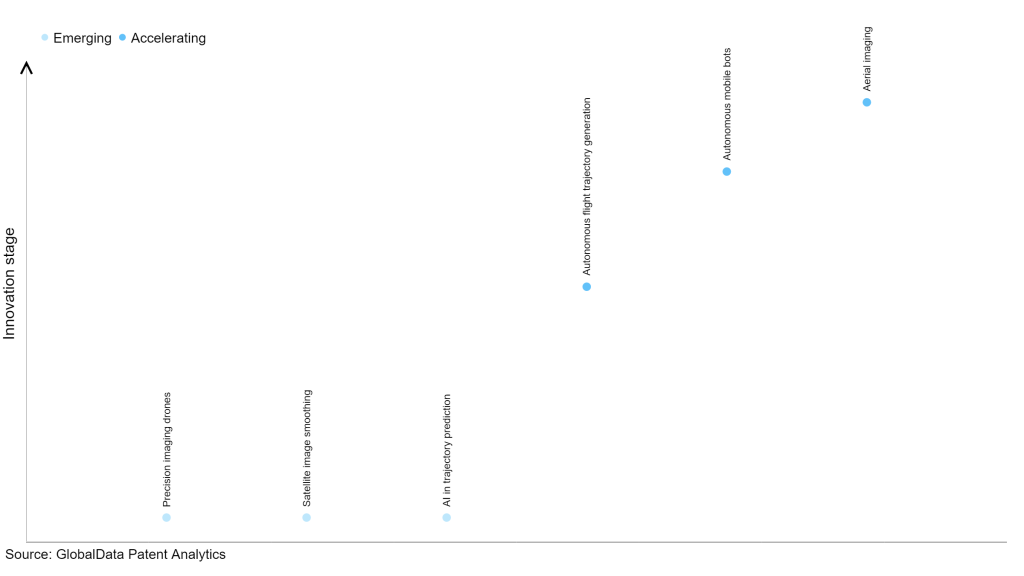The aerospace and defense industry continues to be a hotbed of patent innovation. Activity is driven by developments in artificial intelligence (AI) and machine learning, and the growing importance of technologies such as drones, satellite technology, and big data. In the last three years alone, there have been over 84,000 patents filed and granted in the aerospace and defense industry, according to GlobalData’s report on Artificial intelligence in defense: autonomous navigation controls. Buy the report here.

Discover B2B Marketing That Performs
Combine business intelligence and editorial excellence to reach engaged professionals across 36 leading media platforms.
However, not all innovations are equal and nor do they follow a constant upward trend. Instead, their evolution takes the form of an S-shaped curve that reflects their typical lifecycle from early emergence to accelerating adoption, before finally stabilizing and reaching maturity.
Identifying where a particular innovation is on this journey, especially those that are in the emerging and accelerating stages, is essential for understanding their current level of adoption and the likely future trajectory and impact they will have.
110 innovations will shape the aerospace and defense industry
According to GlobalData’s Technology Foresights, which plots the S-curve for the aerospace and defense industry using innovation intensity models built on over 260,000 patents, there are 110 innovation areas that will shape the future of the industry.
Within the emerging innovation stage, precision imaging drones, satellite image smoothing and AI in trajectory prediction are disruptive technologies that are in the early stages of application and should be tracked closely. Autonomous flight trajectory generation, autonomous mobile bots and aerial imaging are some of the accelerating innovation areas, where adoption has been steadily.
Innovation S-curve for artificial intelligence in the aerospace and defense industry

Autonomous navigation controls is a key innovation area in artificial intelligence
Autonomous navigation controls refer to the systems, devices, and methods used to enable vehicles or robots to navigate and operate autonomously without human intervention. These controls incorporate various technologies such as sensors, communication units, control units, and algorithms to perceive the environment, plan and execute movements, and make decisions for safe and efficient navigation.
GlobalData’s analysis also uncovers the companies at the forefront of each innovation area and assesses the potential reach and impact of their patenting activity across different applications and geographies. According to GlobalData, there are 70+ companies, spanning technology vendors, established aerospace and defense companies, and up-and-coming start-ups engaged in the development and application of autonomous navigation controls.
Key players in autonomous navigation controls – a disruptive innovation in the aerospace and defense industry
‘Application diversity’ measures the number of applications identified for each patent. It broadly splits companies into either ‘niche’ or ‘diversified’ innovators.
‘Geographic reach’ refers to the number of countries each patent is registered in. It reflects the breadth of geographic application intended, ranging from ‘global’ to ‘local’.
Israel Aerospace Industries (IAI) is one of the leading patent filers in autonomous navigation controls. The company has filed patents related to the method of navigating an autonomous ground vehicle to support position or course controlling in two dimensions, image sensing, contour mapping and matching, and planning and execution of driving tasks.
IAI is a leading provider of inertial sensors, inertial navigation, and global navigation satellite system (GNSS) anti-jamming solutions such as gyroscopes, navigation electronics, algorithms, and stabilization units.
Some other key patent filers in the autonomous navigation controls space include Intel, Aptiv, and Alphabet.
In terms of application diversity, Intel, Aptiv, and Alphabet are some of the leading innovators. By means of geographic reach, some of the leading patent filers include Intel, DEKA Research and Development and Israel Aerospace Industries (IAI).
To further understand the key themes and technologies disrupting the aerospace and defense industry, access GlobalData’s latest thematic research report on Artificial Intelligence (AI) in Defense.
Data Insights
From

The gold standard of business intelligence.
Blending expert knowledge with cutting-edge technology, GlobalData’s unrivalled proprietary data will enable you to decode what’s happening in your market. You can make better informed decisions and gain a future-proof advantage over your competitors.




